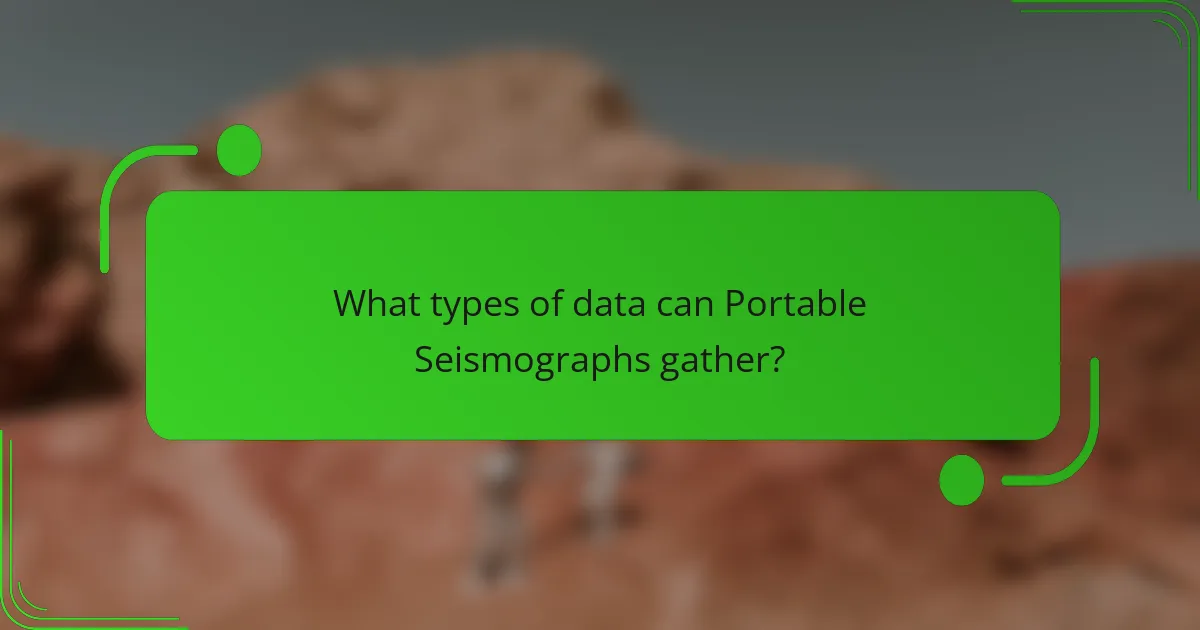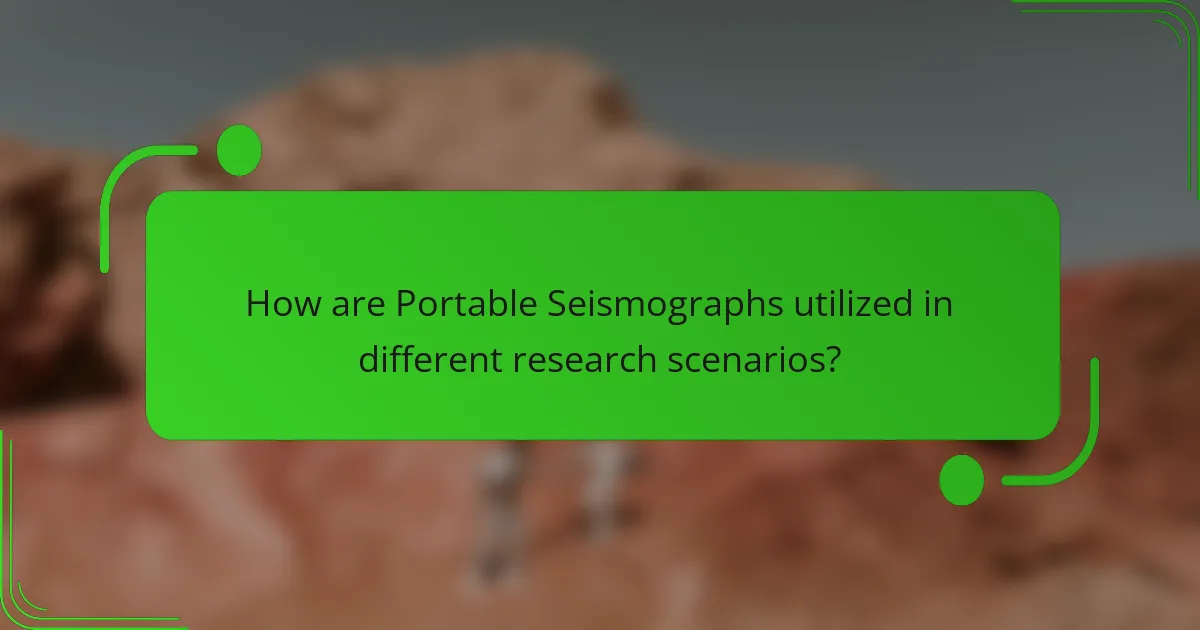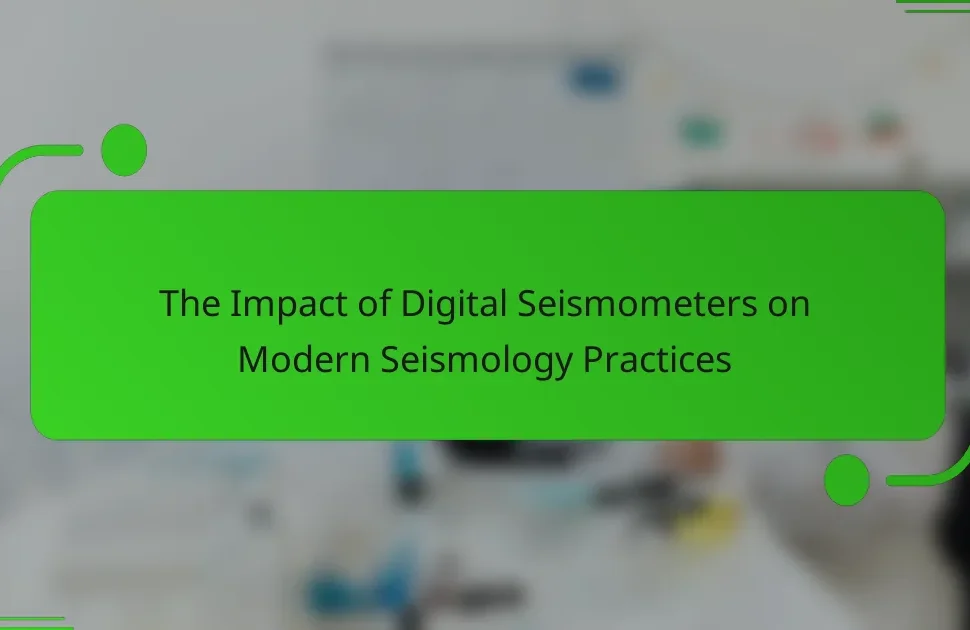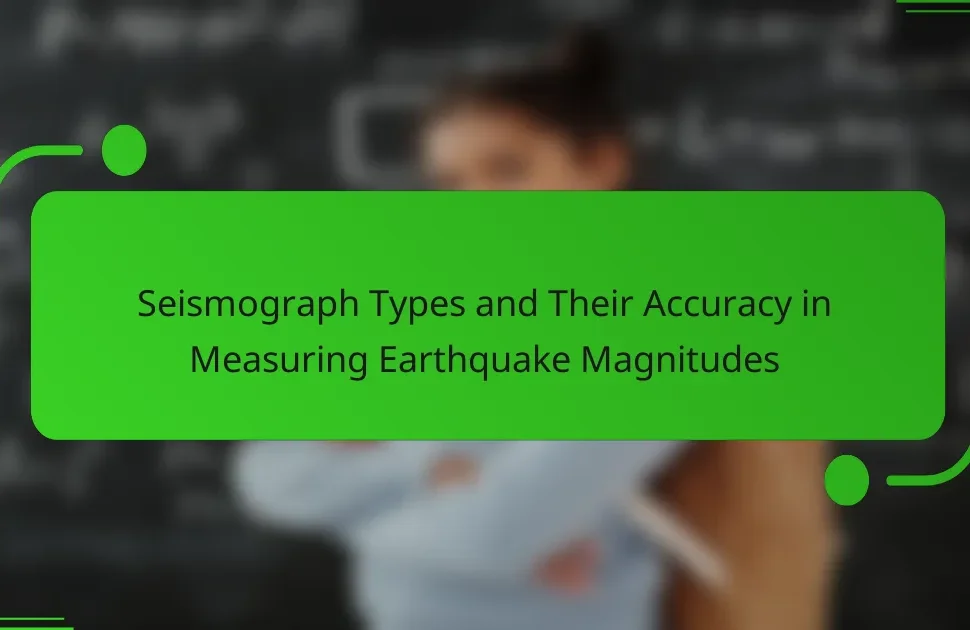Portable seismographs are compact instruments specifically designed to measure seismic activity, including ground motion from earthquakes and explosions. These devices are essential for field research in geology and seismology, providing capabilities such as built-in data storage and wireless connectivity for data collection in remote locations. They capture various seismic data, including P-waves, S-waves, and surface waves, which are critical for understanding tectonic processes and assessing geological hazards. Portable seismographs are widely used in earthquake research, environmental studies, engineering assessments, geological surveys, and educational settings, enhancing the accuracy and efficiency of seismic data gathering and analysis.

What are Portable Seismographs?
Portable seismographs are compact instruments designed to measure seismic activity. They record ground motion caused by earthquakes, explosions, and other seismic events. These devices are essential for field research in geology and seismology. Portable seismographs can be easily transported to various locations. They often include features like built-in data storage and wireless connectivity. Their mobility allows researchers to gather data in remote or hazardous areas. Studies show that portable seismographs improve the accuracy of seismic data collection. This enhances understanding of tectonic processes and earthquake risks.
How do Portable Seismographs function?
Portable seismographs function by detecting ground vibrations caused by seismic waves. They utilize sensors called accelerometers to measure these vibrations. The accelerometers convert mechanical motion into electrical signals. These signals are then processed to determine the characteristics of the seismic event. Portable seismographs can record data in real-time. They often include data storage capabilities for later analysis. Some models are equipped with GPS for precise location data. This functionality allows researchers to monitor seismic activity in various environments.
What are the key components of Portable Seismographs?
The key components of portable seismographs include sensors, data acquisition systems, power sources, and storage devices. Sensors detect ground motion and convert it into electrical signals. Data acquisition systems process these signals for analysis. Power sources, such as batteries, ensure the device operates in the field. Storage devices, often solid-state drives, save the recorded data for later retrieval and analysis. Together, these components enable effective monitoring of seismic activity in various environments.
How do these components contribute to data accuracy?
Portable seismographs enhance data accuracy through precise measurement and reliable data collection. These devices utilize advanced sensors to detect ground vibrations accurately. High-resolution data capture allows for detailed analysis of seismic events. The calibration of instruments ensures consistent performance across various conditions. Additionally, real-time data processing minimizes errors during fieldwork. Portable seismographs also facilitate immediate validation of data, improving overall reliability. Studies have shown that accurate seismic readings lead to better geological interpretations. This contributes to enhanced understanding in fields such as earthquake engineering and resource exploration.
Why are Portable Seismographs important in field research?
Portable seismographs are crucial in field research because they enable real-time data collection on seismic activity. Their mobility allows researchers to deploy them in various locations quickly. This adaptability is essential for monitoring earthquakes and other geological phenomena. Portable seismographs provide high-resolution data that can improve understanding of seismic events. They facilitate the study of ground motion and its effects on structures. Additionally, these instruments help in assessing geological hazards. Their use can lead to better preparedness and response strategies in affected areas. The data gathered can contribute to advancements in seismology and safety measures.
What specific fields benefit from Portable Seismographs?
Geology, engineering, environmental science, and earthquake research benefit from portable seismographs. Geologists use them to study seismic activity and earth structure. Engineers employ them for site assessments and construction planning. Environmental scientists monitor ground vibrations to assess impacts on ecosystems. Earthquake researchers analyze data to improve prediction models and response strategies. These fields rely on the precise measurements provided by portable seismographs to enhance their research and applications.
How do Portable Seismographs enhance data collection methods?
Portable seismographs enhance data collection methods by providing real-time monitoring of seismic activity. They are compact and can be easily deployed in various locations. This mobility allows researchers to gather data from remote or hard-to-reach areas. Additionally, portable seismographs can operate independently, reducing the need for extensive setup. They often feature advanced sensors that improve data accuracy and resolution. The integration of GPS technology allows precise location tracking of seismic events. These devices can transmit data wirelessly, facilitating immediate analysis. Overall, portable seismographs significantly increase the efficiency and effectiveness of seismic data collection.

What types of data can Portable Seismographs gather?
Portable seismographs can gather a variety of data related to ground motion. They measure seismic waves generated by natural or artificial sources. This includes data on P-waves and S-waves, which are primary and secondary seismic waves, respectively. Additionally, they can record surface waves that travel along the Earth’s surface. Portable seismographs also capture information on amplitude, frequency, and duration of seismic events. These instruments can detect vibrations caused by earthquakes, explosions, and other geological activities. The data collected is crucial for understanding seismic activity and assessing geological hazards.
How do Portable Seismographs measure seismic activity?
Portable seismographs measure seismic activity by detecting ground vibrations. They utilize sensitive sensors called geophones to convert these vibrations into electrical signals. These signals are then recorded and analyzed to determine the characteristics of seismic waves. Portable seismographs are designed for field use, making them versatile for various locations. They can measure different types of seismic waves, including P-waves and S-waves. The data collected helps in understanding earthquake patterns and ground stability. Research indicates that portable seismographs can accurately detect seismic events as small as magnitude 2.0. This capability enhances their utility in both scientific research and disaster preparedness.
What are the different types of seismic waves detected?
Seismic waves are classified into two main types: body waves and surface waves. Body waves travel through the Earth’s interior and are further divided into primary (P) waves and secondary (S) waves. P waves are compressional waves that travel fastest and can move through solids and liquids. S waves are shear waves that only travel through solids and arrive after P waves. Surface waves travel along the Earth’s surface and are slower than body waves. They include Love waves, which cause horizontal motion, and Rayleigh waves, which create an elliptical motion. These classifications are fundamental in seismology for understanding earthquake mechanics and wave propagation.
How is data interpreted from seismic readings?
Data from seismic readings is interpreted through analyzing wave patterns. Seismic waves generated by earthquakes or other sources travel through the Earth. These waves are recorded by seismographs. The resulting data shows different wave types, such as P-waves and S-waves.
P-waves are primary waves that travel fastest and indicate the initial location of an event. S-waves follow and provide information about the material they pass through. Analysts measure wave arrival times to determine distance to the seismic source.
Further analysis includes examining wave amplitudes to assess the energy released. Geologists use this data to create models of the Earth’s interior. These models help in understanding tectonic activity and predicting future seismic events.
What are the challenges in using Portable Seismographs?
Portable seismographs face several challenges in usage. First, they can be sensitive to environmental noise, which may interfere with data accuracy. Second, their battery life can be limited, restricting deployment duration in the field. Third, calibration and setup require expertise, which may not always be available on-site. Fourth, data storage capacity can be insufficient for long-term monitoring. Finally, portability may compromise durability, making them vulnerable to damage in harsh conditions. These challenges can hinder effective data collection and analysis in seismic research.
What environmental factors affect their performance?
Environmental factors affecting portable seismographs’ performance include temperature, humidity, and ground conditions. High temperatures can cause equipment overheating, leading to inaccurate readings. Low temperatures may affect battery life and sensor sensitivity. Humidity can lead to condensation, potentially damaging electronic components. Ground conditions, such as soil type and stability, influence seismic wave propagation. Inconsistent ground can result in signal distortion. These factors collectively impact the reliability and accuracy of data collected by portable seismographs in field research.
How can users troubleshoot common issues with Portable Seismographs?
Users can troubleshoot common issues with portable seismographs by following specific steps. First, check the power source to ensure the device is charged or connected properly. Inspect all connections and cables for any visible damage or loose ends. Next, verify that the settings are correctly configured for the intended data collection. If the device is not recording, restart it to reset any potential software glitches. Users should also consult the user manual for troubleshooting specific error codes. Regular maintenance, such as cleaning the sensors, can prevent many issues. Finally, contacting the manufacturer for support can provide additional solutions.

How are Portable Seismographs utilized in different research scenarios?
Portable seismographs are utilized in various research scenarios to measure and analyze seismic activity. They are essential in earthquake research, helping scientists understand tectonic movements. In environmental studies, these devices monitor ground vibrations caused by natural events or human activities. They are also used in engineering to assess soil stability before construction projects. Geological surveys employ portable seismographs to map subsurface structures. In educational settings, they facilitate hands-on learning about seismic phenomena. Their portability allows for field studies in remote locations, enhancing data collection. Research teams rely on these devices for real-time data acquisition, which is crucial for timely analysis.
What are some case studies demonstrating their effectiveness?
Several case studies demonstrate the effectiveness of portable seismographs in field research. One notable study conducted by the United States Geological Survey (USGS) in 2019 utilized portable seismographs to monitor aftershocks following a major earthquake in California. The data collected provided real-time insights into seismic activity and helped refine hazard assessments.
Another case study involved the deployment of portable seismographs in the volcanic region of Iceland. Researchers from the University of Iceland used these devices to track volcanic tremors. The findings enabled timely warnings about potential eruptions, showcasing their critical role in disaster preparedness.
Additionally, a study published in the journal “Seismological Research Letters” highlighted the use of portable seismographs in urban settings. Researchers monitored ground vibrations from construction activities. The results indicated that portable seismographs effectively measured noise pollution and its impact on nearby structures.
These examples illustrate the diverse applications and reliability of portable seismographs in gathering crucial data across various geophysical contexts.
How did Portable Seismographs contribute to a recent field study?
Portable seismographs significantly enhanced a recent field study by providing real-time data collection. They enabled researchers to monitor seismic activity in remote locations efficiently. The devices captured high-resolution seismic waves during geological events. This allowed for immediate analysis and interpretation of tectonic movements. The data gathered contributed to understanding fault lines and earthquake risks. In one instance, the study revealed previously unknown seismic patterns. This information is crucial for improving safety protocols in earthquake-prone areas. Overall, portable seismographs proved essential in advancing geological research and data accuracy.
What lessons were learned from past Portable Seismograph applications?
Past applications of portable seismographs have taught several important lessons. One lesson is the necessity of proper calibration for accurate readings. Inaccurate readings can lead to misinterpretation of seismic data. Another lesson is the importance of user training. Proper training ensures effective operation and data collection. Additionally, data management practices have proven crucial. Effective data organization aids in analysis and interpretation. Environmental factors also play a significant role. Weather conditions can affect equipment performance and data quality. Finally, collaboration with local experts enhances the validity of findings. Engaging with local geologists provides context and improves data relevance.
What best practices should researchers follow when using Portable Seismographs?
Researchers should ensure proper calibration of portable seismographs before deployment. Calibration enhances measurement accuracy and reliability. They must select appropriate locations to minimize noise and interference from human activities. Conducting pre-deployment tests is crucial to confirm functionality and data integrity. Researchers should document environmental conditions during data collection to contextualize results. Regular maintenance of equipment is essential to prevent malfunctions. They should also ensure secure installation to avoid movement during recording. Lastly, data should be analyzed using established methodologies to ensure consistency and validity.
How can researchers ensure data integrity during fieldwork?
Researchers can ensure data integrity during fieldwork by implementing systematic protocols. They should use calibrated instruments to collect accurate data. Regular maintenance of equipment prevents malfunction and data loss. Data should be recorded in real-time to minimize transcription errors. Researchers must establish clear data collection procedures to ensure consistency. They should also back up data frequently to avoid loss. Training field staff on protocols enhances data reliability. Documentation of the data collection process provides transparency and accountability.
What maintenance tips can prolong the lifespan of Portable Seismographs?
Regular calibration of portable seismographs enhances their accuracy and longevity. Ensure that the device is calibrated according to the manufacturer’s specifications. This process helps maintain the reliability of the data collected. Additionally, keeping the seismograph clean prevents dust and debris from interfering with its sensors. Use a soft cloth and appropriate cleaning solutions recommended by the manufacturer.
Proper storage is crucial for maintaining the equipment. Store the seismograph in a protective case when not in use. This protects it from environmental factors such as moisture and extreme temperatures. Regularly check the batteries and replace them as needed to ensure optimal performance.
Lastly, conduct routine inspections for any signs of wear or damage. Addressing minor issues promptly can prevent more significant problems in the future. Following these maintenance tips can significantly prolong the lifespan of portable seismographs.
Portable seismographs are compact instruments designed to measure seismic activity, recording ground motion from events like earthquakes and explosions. This article explores their functionality, key components, and significance in field research across various disciplines such as geology, engineering, and environmental science. It details how these devices enhance data accuracy and collection methods, the types of seismic waves they detect, and the challenges faced in their usage. Additionally, the article highlights best practices for researchers to ensure data integrity and prolong the lifespan of portable seismographs, along with case studies demonstrating their effectiveness in real-world applications.




